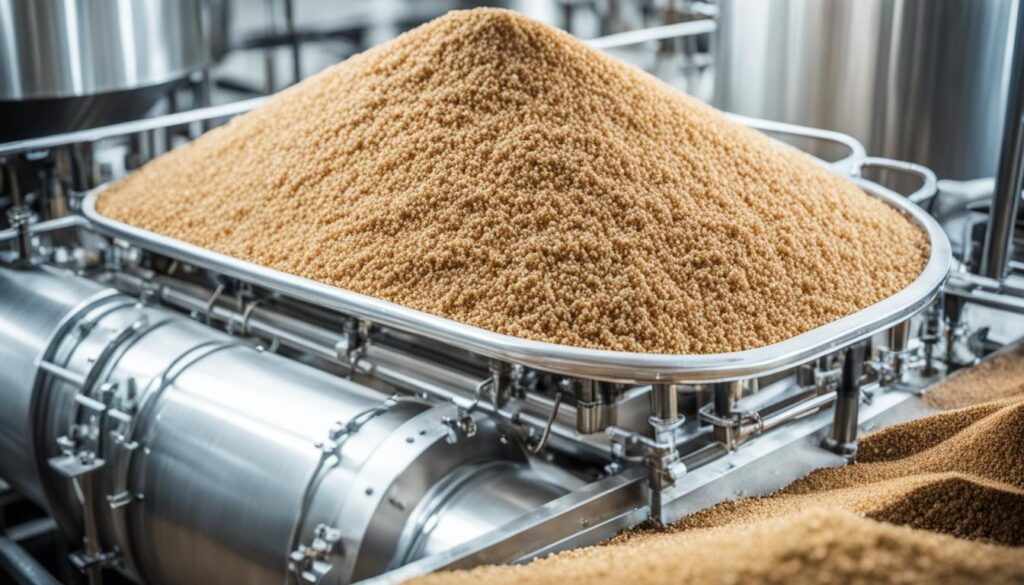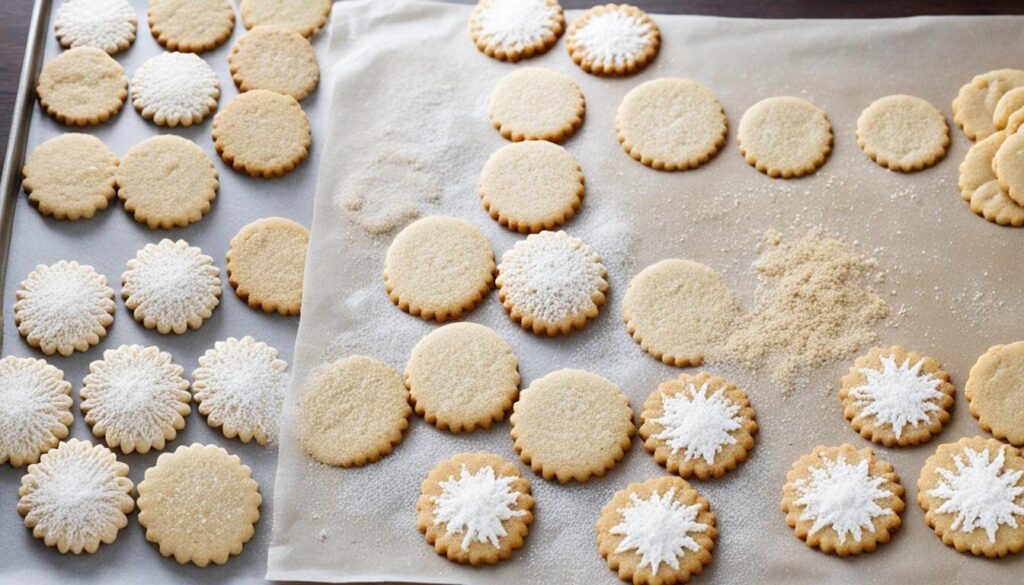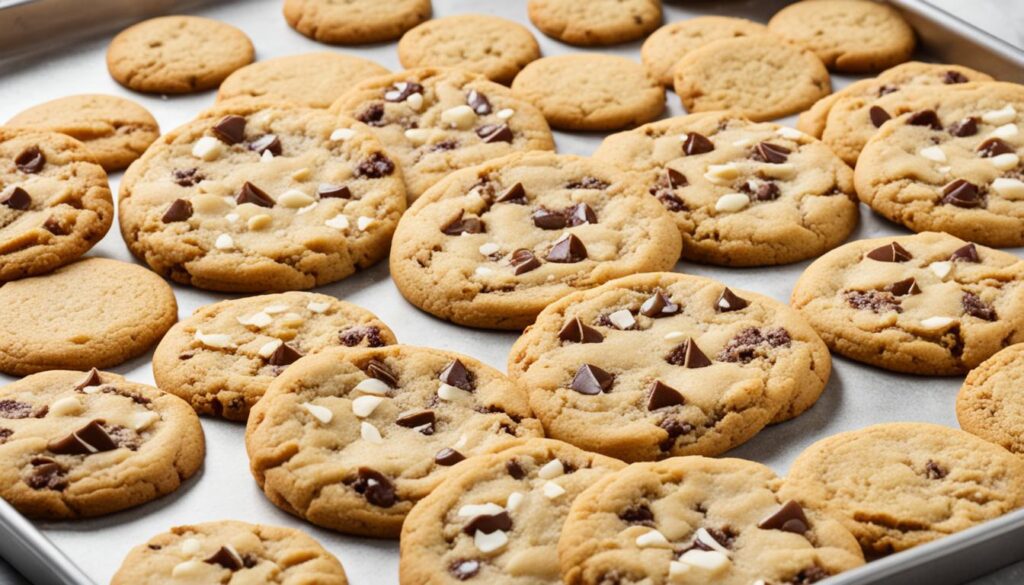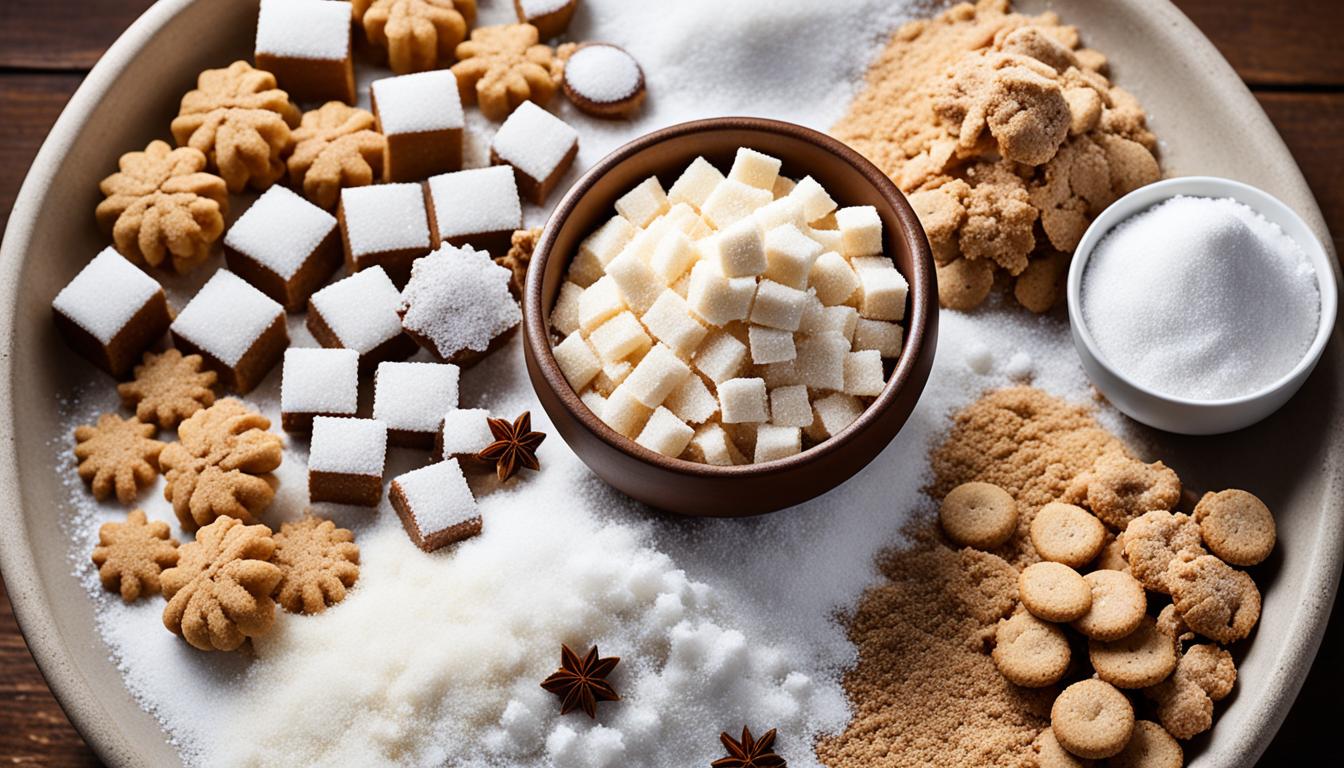Have you ever wondered why some cookies are chewy and moist while others are thin and crispy? The answer lies in the type of sugar used in the recipe. Brown and white sugars are two common options, but what sets them apart? Are there any notable differences between the two when it comes to baking cookies?
In this article, we will delve into the fascinating world of sugar and its impact on cookie baking. We’ll explore the differences between brown and white granulated sugar, their roles in creating delicious cookies, and even share some tips and techniques to achieve the perfect texture and flavor.
Key Takeaways:
- Brown and white sugars have distinct flavor profiles that can greatly influence the taste of cookies.
- The type of sugar used affects the texture, volume, and moisture content of cookies.
- Nutritionally, the differences between brown and white sugar are minimal when considering the small amounts used in baking.
- Both brown and white sugars are derived from sugar cane or sugar beets and go through a similar production process.
- Other ingredients and techniques, such as butter, baking powder, chilling dough, also play a significant role in achieving the desired cookie texture and flavor.
The Role of Sugar in Cookie Baking
Sugar plays a vital role in the art of baking cookies. It serves as the basic building block in cookie dough, affecting various aspects such as pH, volume, density, and moisture content. In cookie baking, two main types of granulated sugar are commonly used: brown sugar and white sugar.
White sugar, also known as granulated sugar, is colorless, odorless, and neutral in flavor. It provides sweetness to the dough without adding any distinct flavor. This allows the flavors of other ingredients, such as vanilla extract or chocolate chips, to shine through. White sugar is versatile and commonly used in a wide range of baked goods.
On the other hand, brown sugar adds a unique touch to cookies. It contains molasses, which is responsible for its characteristic moisture and slight acidity. This moisture enhances the richness and density of the cookies, resulting in a chewier texture. Additionally, the molasses imparts a subtle caramel-like flavor, adding depth to the overall taste profile of the cookies.
“Brown sugar adds moisture and slight acidity, resulting in a denser, moister texture and a caramel-like flavor in cookies.”
When it comes to choosing the best sugar for baking cookies, it largely depends on personal preference and the desired outcome. White sugar is often preferred for cookies that require a light and crispy texture. Meanwhile, brown sugar is favored for those who enjoy a denser and more moist cookie.
The Difference Between Using Granulated Sugar in Cookie Recipes
Here’s a breakdown of how brown sugar and white sugar affect different aspects of cookie baking:
| Aspect | White Sugar | Brown Sugar |
|---|---|---|
| Texture | Thinner and crispier | Denser and moister |
| Flavor | Neutral | Caramel-like |
By understanding the roles of different sugars in cookie baking, you can achieve the desired texture and flavor in your cookies. Experimenting with the use of brown sugar, white sugar, or a combination of both can help you discover new and exciting cookie variations.
Next, let’s dive into the nutritional differences between brown and white sugar in baking cookies.
Nutritional Differences between Brown and White Sugar
When it comes to baking cookies, understanding the nutritional differences between brown and white sugar can help you make informed choices. While both sugars are similar in calorie content, there are a few notable differences to consider.
- Calorie Content: Brown sugar contains slightly fewer calories per teaspoon compared to white sugar.
- Mineral Content: Brown sugar contains higher levels of potassium, iron, and calcium than white sugar.
However, it’s important to note that the differences in mineral content are minimal and may not have a significant impact on your overall nutritional intake when considering the small amounts used in baking cookies.
Below is a table comparing the nutritional composition of brown and white sugar per teaspoon:
| Brown Sugar | White Sugar | |
|---|---|---|
| Calories | 11 | 16 |
| Potassium (mg) | 22 | 0 |
| Iron (mg) | 0.03 | 0 |
| Calcium (mg) | 2 | 0 |
Production Process of Brown and White Sugar
Both brown and white sugars are derived from sugar cane or sugar beets and go through a similar production process. However, the key difference lies in the addition of syrup to brown sugar, which gives it its distinctive color and deeper caramel flavor. Let’s take a closer look at the production process of brown and white sugar.
Brown Sugar Production
The production of brown sugar involves the following steps:
- Affination: The sugar cane or sugar beets are harvested and sent to the sugar mill for processing. The raw material undergoes affination, which involves removing impurities such as leaves, stems, and dirt.
- Purification: After affination, the sugar juice is extracted, and further purification processes are carried out to remove any remaining impurities.
- Decolorization: The purified sugar juice is then clarified and filtered to remove any colorants and solid particles.
- Crystallization: The clarified sugar juice is heated and concentrated, causing the sucrose molecules to crystallize. The resulting sugar crystals are then separated from the remaining syrup.
- Syrup Addition: In the case of brown sugar, a specific amount of molasses syrup is added to the sugar crystals. The syrup imparts the characteristic flavor, color, and moisture to brown sugar.
- Sterilization: After the syrup addition, the brown sugar undergoes sterilization to ensure product safety and extend its shelf life.
- Final Filtration: The sterilized brown sugar is filtered once more to remove any remaining impurities before packaging.
White Sugar Production
The production process of white sugar follows a similar path as brown sugar, with the key difference being the omission of the syrup addition step. This results in white sugar’s colorless and neutral characteristics.
Below is a comparison table highlighting the key differences in the production process of brown and white sugar:
| Production Process Stage | Brown Sugar | White Sugar |
|---|---|---|
| Affination | ||
| Purification | ||
| Decolorization | ||
| Crystallization | ||
| Syrup Addition | N/A | |
| Sterilization |  |
|
| Final Filtration |
With an understanding of the production process, we can appreciate the unique qualities and flavor profiles that brown and white sugar bring to our baked goods.
Taste Differences between Brown and White Sugar
Brown and white sugars offer distinct flavor profiles in baking cookies. White sugar, with its neutral flavor, is sweeter, making it a versatile choice for various baked goods. On the other hand, brown sugar adds a deeper caramel or toffee-like flavor to cookies, along with a light amber color.
When deciding which sugar to use in your cookie recipe, consider the desired taste and color of the final product. White sugar will provide a sweeter and more neutral taste, allowing the flavors of other ingredients to shine. Brown sugar, however, will bring a richer, caramel-like flavor to your cookies.
Ultimately, the choice between brown and white sugar depends on personal preference and the desired flavor profile. If you’re looking for a classic, sweet taste, white sugar is your best bet. For those seeking a more complex and indulgent flavor, brown sugar is the way to go.

| Sugar | Taste | Color |
|---|---|---|
| White Sugar | Neutral, sweet | Colorless |
| Brown Sugar | Caramel, toffee-like | Light amber |
Impact of Different Sugars on Cookie Texture
The type of sugar used in a cookie recipe can have a significant impact on its texture. When baking soda is present, the acidic nature of brown sugar reacts with the baking soda to produce carbon dioxide, resulting in thick, puffy, and soft cookies. On the other hand, white sugar does not participate in this reaction, leading to thinner, denser, and crispier cookies.
Brown sugar also plays a role in gluten development in cookie dough. The presence of molasses in brown sugar aids in the formation of gluten strands, which lend a thicker and more tender/chewy texture to cookies. In contrast, white sugar does not contribute to gluten development, resulting in cookies that are less chewy but more crisp.
The choice between brown and white sugar in cookie baking is ultimately a matter of personal preference. If you prefer thicker, softer cookies with a caramel-like flavor, brown sugar is the way to go. However, if you enjoy cookies that are thin, crispy, and have a more neutral sweetness, white sugar is the better option.
Experimenting with different sugar types and ratios allows you to fine-tune your cookie recipes to achieve the desired texture. Take note of how each sugar affects the dough’s consistency and adjust as needed. Remember, the type of sugar is just one of many factors that influence cookie texture, so don’t forget to consider other ingredients and techniques as well.
Summary:
- Brown sugar reacts with baking soda to create a thicker, puffy, and soft cookie texture
- White sugar does not participate in the baking soda reaction, resulting in thinner, denser, and crispier cookies
- Brown sugar aids in gluten development, creating a thicker and more tender/chewy texture
- White sugar does not contribute to gluten development, resulting in less chewy and more crisp cookies
- The choice between brown and white sugar depends on personal preference for texture and flavor
- Experimentation with sugar types and ratios allows for customization of cookie texture
Using Brown vs. White Sugar in Cookie Recipes
When it comes to baking cookies, brown and white sugars are often used interchangeably. However, it’s important to keep in mind that substituting one for the other can impact the texture and flavor of your delicious treats. Let’s explore how you can substitute brown sugar for white sugar in baking to achieve the desired results.
- Texture: Brown sugar has a higher moisture content than white sugar, which makes cookies denser, moister, and chewier. On the other hand, white sugar leads to thinner, crispier cookies due to its lower moisture content.
- Flavor: Brown sugar adds a subtle caramel-like flavor to cookies, while white sugar is more neutral in taste and allows other ingredients to shine.
When substituting brown sugar for white sugar in your cookie recipes, keep in mind that the texture and flavor will be affected. If you prefer denser, moister, and chewier cookies, using brown sugar is a great option. However, if you’re aiming for thinner and crispier cookies, white sugar is the way to go.
It’s important to consider the specific recipe and the roles sugar plays in it. Some cookie recipes rely on the moisture and acidity of brown sugar to achieve the desired results. In these cases, substituting white sugar might significantly alter the outcome. It’s always a good idea to experiment and see what works best for your taste preferences.
| Substitution | Texture | Flavor |
|---|---|---|
| Brown sugar for white sugar | Denser, moister, and chewier | Subtle caramel-like flavor |
| White sugar for brown sugar | Thinner and crispier | Neutral flavor |
Remember, when substituting sugars in your cookie recipes, it’s not just about the sweetness but also the impact on texture and taste. Consider experimenting with different combinations to achieve the perfect cookie for your preferences.
Impact of Other Ingredients in Cookie Baking
When it comes to baking cookies, the impact of other ingredients cannot be overlooked. Besides sugar, several other key ingredients play a crucial role in determining the texture and flavor of your cookies.
Melted Butter vs. Creamed Butter
The choice between using melted butter and creamed butter can significantly influence the outcome of your cookies. Melted butter tends to produce tender and flatter cookies, while creamed butter creates air pockets during creaming, resulting in puffy cookies.
Effect of Baking Powder and Baking Soda
Baking powder and baking soda are leavening agents that affect the rise, thickness, and softness of cookies. Baking powder, when combined with an acidic ingredient like brown sugar, produces a chemical reaction that releases carbon dioxide, resulting in thicker and softer cookies. On the other hand, baking soda promotes spread, leading to thinner and crispier cookies.
Chilling Dough for Enhanced Texture
The chilling process is essential for achieving the desired texture in cookies. By refrigerating the dough for at least 24 hours, the ingredients have time to meld together, resulting in a more developed flavor and a firmer dough structure. As a result, chilled dough leads to flatter and crispier cookies when they are baked.
Understanding the impact of these ingredients allows us to experiment and fine-tune our cookie recipes based on personal preferences. By adjusting the butter, leavening agents, and dough chilling time, we can achieve the ideal texture and flavor in our baked treats.
| Ingredient | Impact on Cookie Texture |
|---|---|
| Melted Butter | Tender and flat cookies |
| Creamed Butter | Puffy cookies with air pockets |
| Baking Powder | Thicker and softer cookies |
| Baking Soda | Thinner and crispier cookies |
| Chilled Dough | Flatter and crispier cookies |
Tips for Achieving the Desired Cookie Texture
Achieving the perfect texture in your cookies requires careful consideration of various factors. From the type of sugar used to the ratios and techniques employed, every detail plays a role in the final result. Here are some valuable tips to help you achieve the desired cookie texture:
- Experiment with different sugar types: Brown and white sugars have distinct characteristics that can significantly impact cookie texture. Try using different types of sugar in your recipes to understand their effects. White sugar will result in thinner and crispier cookies, while brown sugar will add moisture and create a denser, chewier texture.
- Adjust sugar ratios: The amount of sugar used can also affect cookie texture. Increase the amount of brown sugar for a softer and chewier cookie, or reduce the sugar overall for a crisper texture.
- Vary the mixing technique: The way you mix the sugar and other ingredients can influence cookie texture. Creaming the sugar and butter together will create more air pockets, resulting in a lighter texture. Combining the sugar and butter without creaming will yield denser cookies.
- Consider the impact of other ingredients: In addition to sugar, other ingredients like butter, eggs, and leavening agents can affect cookie texture. Experiment with different types and amounts of these ingredients to achieve the desired consistency.
Remember, achieving the perfect cookie texture may require a bit of experimentation. Be open to trying different sugar types, ratios, and techniques until you find the combination that suits your preferences. The process of baking cookies is as much about creativity and exploration as it is about precise measurements and instructions.
Tips for Adjusting Cookie Texture
Here are additional tips to help you adjust the texture of your cookies:
- For softer cookies: Increase the amount of moisture in your recipe by using brown sugar or adding ingredients like honey or molasses. You can also reduce the baking time to keep the cookies slightly doughy in the center.
- For crunchier cookies: Use white sugar or granulated sugar to create a crisper texture. You can also try baking the cookies for a longer duration to achieve a golden brown color and increased crispness.
- For chewier cookies: Increase the amount of fat in your recipe by adding more butter or using ingredients like vegetable oil. Using brown sugar can also contribute to a chewier texture.
- For flatter cookies: If you prefer flatter cookies with a crispier texture, reduce the amount of fat and leavening agents in your recipe. Additionally, increasing the baking temperature can help spread the dough more during baking, resulting in flatter cookies.
By considering the sugar type, adjusting ratios, varying mixing techniques, and experimenting with other ingredients, you can achieve the perfect cookie texture to suit your taste preferences. Enjoy the process of cookie baking and let your creativity guide you!
| Sugar Type | Cookie Texture |
|---|---|
| Brown Sugar | Denser, moister, and chewier |
| White Sugar | Thinner and crispier |
Experimenting with different types of sugar and adjusting their ratios can lead to a range of delightful cookie textures.
“Baking is an art that allows us to explore and create delicious treats. Don’t be afraid to mix things up and discover your own unique cookie textures.” – Anonymous

Conclusion
After exploring the differences between brown and white granulated sugar in cookie baking, it is clear that they offer distinct flavors and texture profiles. Brown sugar contributes moisture, acidity, and caramel notes, resulting in denser, moister, and chewier cookies. On the other hand, white sugar provides sweetness without significant flavor contributions, leading to thinner and crispier cookies. The choice between the two sugars ultimately depends on personal preference and the desired outcome in cookie texture and flavor.
However, it’s important to note that the impact of sugar in cookies is just one piece of the puzzle. Other ingredients and techniques, such as the type of butter used, the leavening agents added, and chilling the dough, also play significant roles in achieving the desired cookie texture.
When baking cookies, it’s always recommended to experiment and fine-tune recipes based on individual preferences. Consider the characteristics of brown and white sugars, as well as the interplay with other ingredients, to create the perfect batch of cookies. Remember to make small adjustments and take note of how each change affects the final outcome. Enjoy the process of creating delicious cookies with different sugar variations.
| Key Differences | Brown Sugar | White Sugar |
|---|---|---|
| Texture | Denser, moister, and chewier | Thinner and crispier |
| Flavor | Added moisture, acidity, and caramel notes | No significant flavor contributions |
| Color | Produces a darker color in cookies | No impact on cookie color |
Additional Tips for Cookie Baking
When it comes to baking cookies, experimenting with different sugar types, ratios, and techniques can elevate your recipes to new heights. Whether you’re using brown sugar, white sugar, or a combination of both, consider their unique characteristics and how they interact with other ingredients to achieve the desired texture and flavor in your cookies.
Start by making small adjustments and taking note of how each change affects the final outcome. If you want denser, moister, and chewier cookies, try using more brown sugar in your recipe. On the other hand, if you prefer thinner and crispier cookies, opt for a higher proportion of white sugar. Finding the perfect balance is all about personal preference.
Don’t forget to pay attention to other ingredients as well. The type of fat (butter, margarine, or shortening), leavening agents (baking powder or baking soda), and even the process of chilling the dough can all influence the texture and flavor of your cookies.
Lastly, don’t forget to enjoy the process of creating delicious cookies with different sugar variations. Baking is an art, and every batch of cookies is an opportunity to experiment, learn, and satisfy your sweet tooth. So, let your creativity soar and savor the delightful results!
